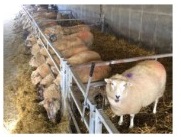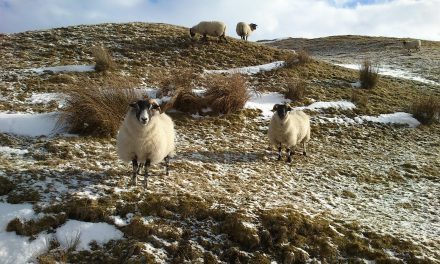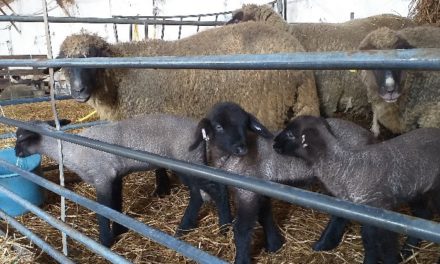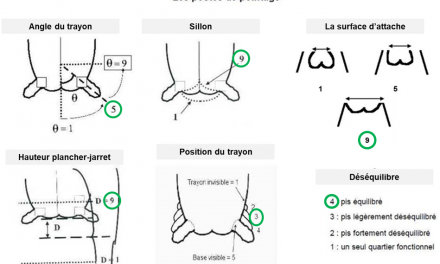This post is also available in:
![]()
![]()
![]()
![]()
![]()
Country: Romania
Dairy or/and meat sheep: Dairy and Meat
Source of information: Industry and research
Level of solution: Knowledge/Practical
Aim: To help ewe nutrition monitoring and evaluation during pregnancy
Description:
- When ewes are kept post-breeding on pastures, they should have high quality, with a structure of 40% legumes and 60% grasses, and a height of the plants of 8-12 cm, allowing a feed intake of 5 to 7 kg/day.
- Changes in feeding regime should be made gradually, during a period of 6 to 8 days.
- Weight of the lamb(s) is developing primarily (>70%) during the last two months of gestation.
- Ewes should gain 8-14 kg during pregnancy, most of that weight gain being in the placenta and fetus, and lose only 5% of true live-weight in the six weeks following lambing.
- Adult ewes can be fed during indoor housing, diets consisting of hay (1.5-3 kg), silages (1.5-2 kg) and concentrates (0.1-0.5 kg), depending on the animal’s body condition.
- Ewes in their last weeks before lambing (3-4 weeks) reduce their voluntary intake with up to 25-30%, due to the fetus growth.
Expected benefits: Targeting ewe nutrition and monitoring the BCS could lead to a decrease of the embryonic losses and a proper development of the lamb(s).
Prerequisites and/or limits (knowledge, training, capabilities, cost, management, facilities, equipment, etc.)
- Farmers need to be able to manage the animals according to the body condition score and periodically monitor the weight gain. Ewes should be managed in groups of 40 to 60 ewes, based on their age, gestation type and weight.
Scientific publications:
Holst PJ Australian Journal of Agricultural Research 37(6) 647 – 655
Rook Veterinary Clinics of North America: Food Animal Practice 2000 16(2) : 293-317
Munoz et al Animal. 2008 Jan;2(1):52-63.
Tips & Tricks:
- Ewe nutrition for optimum lamb birth weight
- Producing high feed value silage
- Using yokes for BCS grouping
- Calibrated bucket
- Tasting lupin seed
Expected impacts:
| Benefit | |||||||
| Benefit expected | Increase productivity less abortion less mortality better feed management |
||||||
| System | |||||||
| Is the solution suitable for various production systems | Y | ||||||
| If no – for which system | dairy & meat | ||||||
| Cost | |||||||
| What are the asset costs | <100/ewe | ||||||
| What are the maintenance costs | <50/ewe | ||||||
| Any limits to its applicability | No | ||||||
| Work Load | |||||||
| Farmers | Service provider/tech.-vet-others | ||||||
| How much time is required to prepare and implement the solution | >=1week | ||||||
| How many people is needed to implement the solution? | 1 person (the farmer) | ||||||
| Timing | |||||||
| How long it takes to get results? | >=1week | ||||||
| How long it takes to see an effect on sheep productivity? | current production period | ||||||
| Equipment/Facility | |||||||
| Farmers | Service provider/technicians-vet-others | ||||||
| What kind of equipment/tool are necessary? | Concentrate feeders, fences for grazing management, seeds for pastures | ||||||
| Skill/Knowledge-Training (farmer) | |||||||
| Does the solution need any specific skill/knowledge or training? | Yes | ||||||
| How much time will be required for training | 1 day training | ||||||
| Wider Environment | |||||||
| Is there any particular regulation link to the solution? | NO | ||||||
| Does the solution need any particular structure or organisation? | NO | ||||||
Users’ evaluation:
|
Country |
ROMANIA |
|
Solution No/Name |
22. Nutrition management in gestation ewes |
|
Farmer/Service provider/technicians-vet-others |
Farmers |
|
Why did you select this solution? |
Reduces abortion incidence Better survival in lambs and more vigorous offspring |
|
Was it easy to implement? |
Yes |
|
If not say what are the identified drawbacks? |
|
|
Did you need to adapt it? |
No |
|
If yes, how? |
|
|
Were you happy with the outcome of the solution? |
Yes |
|
What were the outcomes? |
Better gestation rates |
|
Score the solution |
Interesting and easy to implement |
|
Will you continue to implement it? |
Yes |
|
If not, for which reasons? |
|
|
Comments/Additions |
The legumes proportion in the pastures should not exceed 25% |







